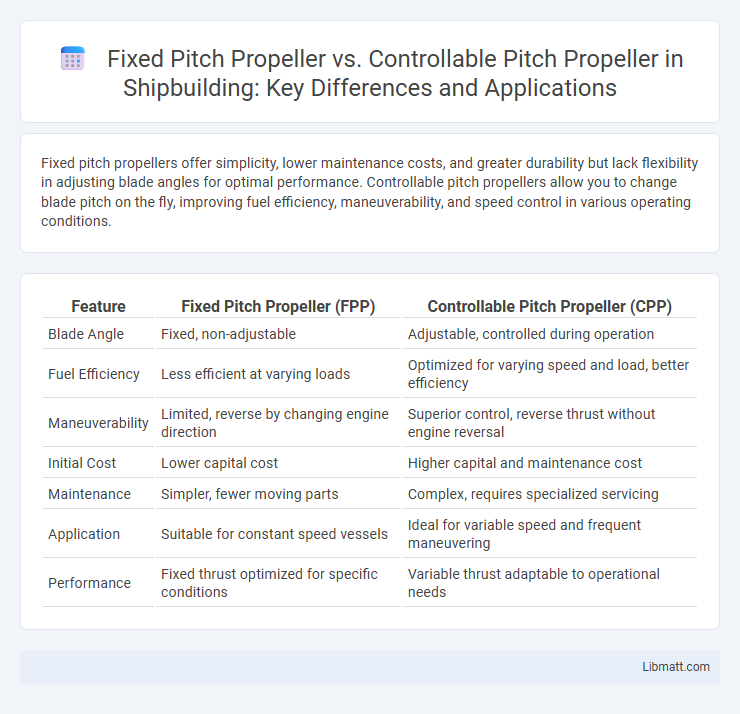Fixed pitch propellers offer simplicity, lower maintenance costs, and greater durability but lack flexibility in adjusting blade angles for optimal performance. Controllable pitch propellers allow you to change blade pitch on the fly, improving fuel efficiency, maneuverability, and speed control in various operating conditions.
Table of Comparison
| Feature | Fixed Pitch Propeller (FPP) | Controllable Pitch Propeller (CPP) |
|---|---|---|
| Blade Angle | Fixed, non-adjustable | Adjustable, controlled during operation |
| Fuel Efficiency | Less efficient at varying loads | Optimized for varying speed and load, better efficiency |
| Maneuverability | Limited, reverse by changing engine direction | Superior control, reverse thrust without engine reversal |
| Initial Cost | Lower capital cost | Higher capital and maintenance cost |
| Maintenance | Simpler, fewer moving parts | Complex, requires specialized servicing |
| Application | Suitable for constant speed vessels | Ideal for variable speed and frequent maneuvering |
| Performance | Fixed thrust optimized for specific conditions | Variable thrust adaptable to operational needs |
Introduction to Marine Propellers
Fixed pitch propellers have blades set at a constant angle, offering simplicity, durability, and lower maintenance costs, making them ideal for vessels with consistent speed requirements. Controllable pitch propellers provide adjustable blade angles, allowing for enhanced fuel efficiency, better maneuverability, and optimized performance across varying speeds and load conditions. Choosing the right marine propeller influences your vessel's propulsion efficiency and operational flexibility in diverse maritime environments.
Understanding Fixed Pitch Propellers
Fixed pitch propellers have blades set at a constant angle, providing simplicity, durability, and low maintenance for steady-speed operations. These propellers are optimized for specific engine RPM and load conditions, offering efficient thrust in consistent performance scenarios. Understanding your vessel's operating profile helps determine if a fixed pitch propeller meets your reliability and cost-effectiveness needs.
How Controllable Pitch Propellers Work
Controllable pitch propellers (CPP) adjust blade angles hydraulically or mechanically to optimize thrust and fuel efficiency under varying operating conditions. By changing the pitch, CPPs enable precise control of vessel speed and maneuverability without altering engine RPM, enhancing performance in diverse maritime environments. This adaptability reduces engine wear and improves fuel consumption compared to fixed pitch propellers, making CPPs ideal for vessels requiring variable speed and load management.
Key Differences Between Fixed and Controllable Pitch
Fixed pitch propellers feature blades set at a constant angle, optimizing efficiency for specific speeds and conditions, while controllable pitch propellers allow blade angle adjustment during operation, enhancing versatility and performance. You benefit from improved fuel efficiency and maneuverability with controllable pitch propellers, especially in variable speed or load environments. Fixed pitch systems are simpler, less expensive, and require less maintenance but lack the adaptability of controllable pitch designs.
Performance Comparison: Efficiency and Maneuverability
Fixed pitch propellers offer simplicity and reliability with optimized efficiency at a specific speed and load, making them ideal for consistent cruising conditions. Controllable pitch propellers enhance maneuverability by allowing blade angle adjustments, improving fuel efficiency and thrust across varying speeds and operational demands. Your choice depends on whether you prioritize straightforward performance or adaptable efficiency and handling in diverse marine environments.
Maintenance Requirements and Operational Costs
Fixed pitch propellers require less maintenance due to their simpler design with fewer moving parts, resulting in lower operational costs over time. Controllable pitch propellers, with their adjustable blades and hydraulic systems, demand more frequent inspections and servicing, increasing maintenance expenses. However, their ability to optimize performance under varying conditions can lead to fuel savings that partially offset higher upkeep costs.
Applications and Suitability for Different Vessels
Fixed pitch propellers are ideal for smaller vessels and applications where cost-effectiveness and simplicity are priorities, such as recreational boats and small fishing vessels, providing reliable performance in steady operating conditions. Controllable pitch propellers offer greater maneuverability and efficiency across varying speeds and loads, making them suitable for commercial ships, ferries, and offshore vessels that require precise thrust control and fuel economy. Your choice depends on vessel type, operational profile, and the need for adaptability in propulsion performance.
Advantages of Fixed Pitch Propellers
Fixed pitch propellers offer simplicity and reliability due to their solid, unchangeable blade angle, which reduces maintenance needs and initial costs. These propellers provide consistent performance at a specific design speed, making them ideal for vessels with predictable operating conditions. Your choice of a fixed pitch propeller ensures lower weight and enhanced durability, benefiting applications requiring straightforward, dependable propulsion.
Benefits of Controllable Pitch Propellers
Controllable pitch propellers enhance vessel efficiency by allowing real-time adjustment of blade pitch to optimize thrust across varying speeds and load conditions. This adaptability improves fuel economy, reduces engine wear, and enhances maneuverability, especially during docking or in adverse weather. Your ship benefits from increased operational flexibility and performance, making controllable pitch propellers a preferred choice for dynamic maritime applications.
Choosing the Right Propeller for Your Vessel
Choosing the right propeller for your vessel depends on factors such as vessel size, operating conditions, and maneuverability requirements. Fixed pitch propellers offer simplicity, durability, and cost-effectiveness, ideal for vessels with consistent speed and load profiles. Controllable pitch propellers provide enhanced efficiency, improved fuel economy, and precise thrust control, making them suitable for vessels requiring variable speeds and frequent directional changes.
Fixed pitch propeller vs controllable pitch propeller Infographic

 libmatt.com
libmatt.com